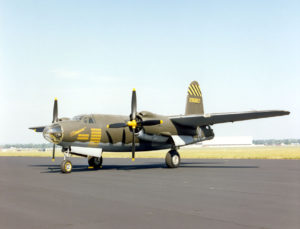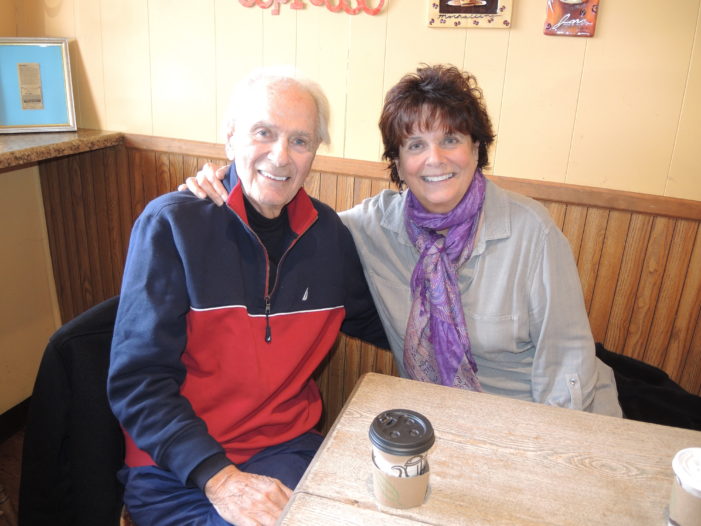World War II veteran Jim Manilla, with his daughter Cam Manilla of Clarkston. Photo by Phil Custodio
BY PHIL CUSTODIO
Clarkston News Editor
Newly arrived in World War II England, Jim Manilla received an unexpected visitor.
“Believe it or not, I was shining my shoes and I looked up and my brother (John) is standing there. I hadn’t seen him in two years. I hardly recognized him,” Jim said.
Flying with a B-17 heavy bomber crew, John had lost weight, dropping from about 180 to 160 pounds.
“He had completed half of his missions and I was just beginning,” said Jim, the third of three sons – himself, John, and Paul – all serving in the military at the same time.
Now 94 years old and living in Arizona, Jim likes to visit his son Robert Manilla and daughter Cam Manilla, both Clarkston residents, with John visiting occasionally from New York.
Jim was drafted and inducted into the U.S. Army the February after he graduated from high school in central New York.
He trained at army posts across the country, including Ft. Dix in New Jersey, Fort Myers, Fla., as well as Louisiana and Georgia. Going into the Army Air Corps, training included flying in single engine AT-6 Texan planes.
“It was the first time I’d ever been up in an airplane,” he said.
Aerial gunnery training included flying in an open cockpit, trying to hit a fabric sleeve pulled by a cargo plane.
“I’d pull the trigger on the .50-caliber machine gun and watch tracer bullets going toward this target and just praying to God that I wouldn’t hit the plane,” he said.
After applying as an aviation cadet, he was sent to the University of North Dakota in Grand Forks for six months of training, learning how to fly on a Piper Cub.
“I didn’t do very well but I managed to survive that ordeal,” he said.

Then came training as a bombardier and navigator on a B-26 Marauder medium bomber.
“We flew over the Gulf of Mexico,” he said. “I was the navigator, trying to keep the crew from getting lost.”
He was commissioned a second lieutenant, and he and the rest of the six-man crew were shipped overseas.
It was after the D-Day invasion of June 6, 1944, and they were based with the Ninth Air Force about 65 miles north of Paris. Their mission was to bomb targets along the Rhine River in Germany.
“We had two engines so we didn’t have long flights like the B-17 bomber – they flew into the heart of Germany, four hours in and four hours back,” he said. “We flew two hours in, two hours back.”
By that point in the war, they didn’t face the waves of German fighter planes bomber forces fought earlier, but anti-aircraft gun fire was still heavy and deadly.
“You always wondered when your number would come up. Being Catholic, I would always have a Rosary,” he said. “You had to do it and know you may not come back, but then you saw your buddies who you had breakfast with or chatted with the day before and then the next day they’re gone.”
As navigator and bombardier, he sat up front in the bomber behind a plexiglass nosecone, with helmet and flak vest for protection.
“We had what we call a Norden bombsight – it was a good sight,” he said. “We were issued .45 pistols, and if we were shot down, we were charged with the responsibility of shooting into the bomb site to destroy it so the German wouldn’t get it.”
They flew a full tour of 35 missions without serious damage or injury to the crew.
“It was an interesting experience, seeing the flak coming up, and I’m sitting up in the nose, of course, of the B-26 – when you hit Germany, you look down and all you see is black smoke,” he said.
He was due for a furlough after 35 missions, but the war ended before he could go.
“I was appointed the athletic director of the base, and my job was to develop athletic facilities like baseball,” he said
He went to prison camps for labor – German prisoners of war.
“It was kind of a sad experience. Many of them were 16, 17 years old,” he said.
He did that for about three months, then was shipped back to America where he was discharged from the Army.
After the war, he studied at the University of Michigan, where he was an athlete in baseball, basketball, and football.
“The GI Bill really provided an opportunity for me to get my undergraduate, masters, and my doctorate,” he said. “The GI Bill was the most rewarding piece of legislation passed by Congress.”
He was a teacher, football coach, and athletic director before working as dean of students at community colleges for 25 years, and has four children – Robert, Cam, Dani, and Kathy – eight grandchildren, and a great-grandson.
Jim was vice president of development at the University of Arizona when he retired at age 88.
“I’ve been very fortunate in my life. I’ve lived 94 years and have pretty good health,” he said.


One Response to "35 missions over Germany during World War II"